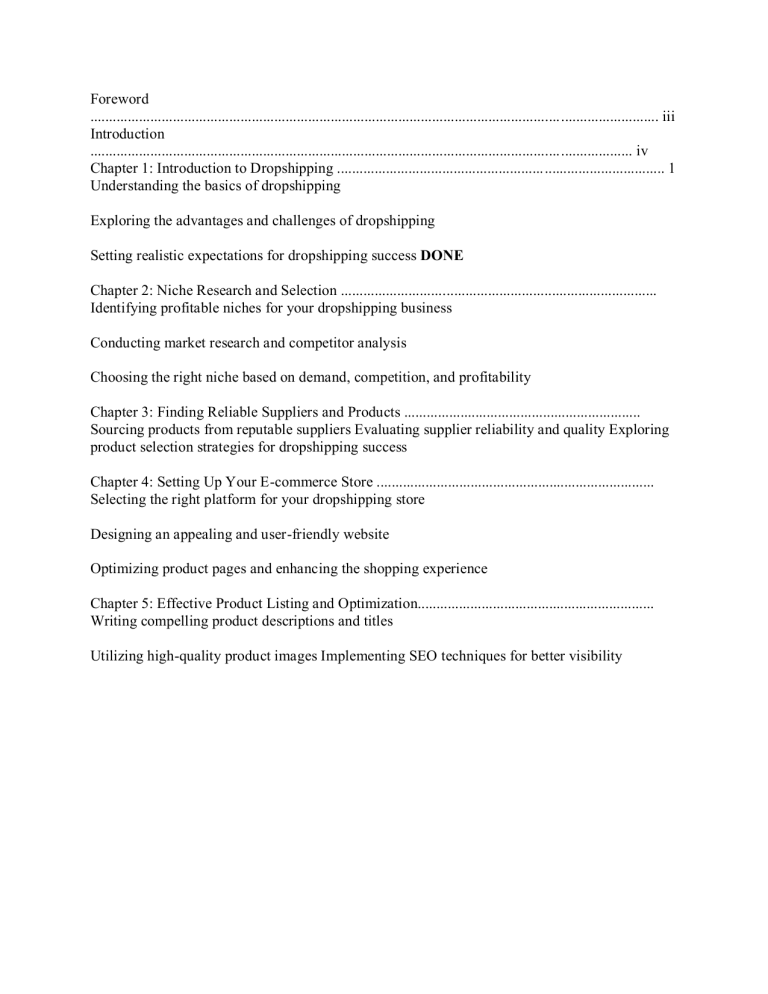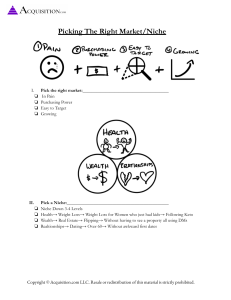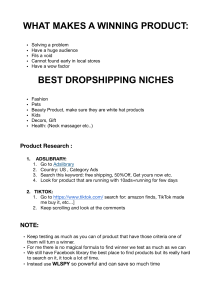
Foreword ....................................................................................................................................................... iii Introduction ................................................................................................................................................ iv Chapter 1: Introduction to Dropshipping ....................................................................................... 1 Understanding the basics of dropshipping Exploring the advantages and challenges of dropshipping Setting realistic expectations for dropshipping success DONE Chapter 2: Niche Research and Selection .................................................................................... Identifying profitable niches for your dropshipping business Conducting market research and competitor analysis Choosing the right niche based on demand, competition, and profitability Chapter 3: Finding Reliable Suppliers and Products ............................................................... Sourcing products from reputable suppliers Evaluating supplier reliability and quality Exploring product selection strategies for dropshipping success Chapter 4: Setting Up Your E-commerce Store .......................................................................... Selecting the right platform for your dropshipping store Designing an appealing and user-friendly website Optimizing product pages and enhancing the shopping experience Chapter 5: Effective Product Listing and Optimization............................................................... Writing compelling product descriptions and titles Utilizing high-quality product images Implementing SEO techniques for better visibility Exploring the advantages and challenges of dropshipping In the preceding section, we embarked on a journey through the fundamental concepts of drop shipping. Now, let's dive deeper into the intriguing aspects that shape the landscape of this dynamic business model by exploring both its compelling advantages and the unique challenges it presents. Advantages of Dropshipping: 1. Low Startup Costs: One of the most enticing aspects of drop shipping is its low barrier to entry. Unlike traditional retail, which often demands substantial upfront investments in inventory and infrastructure, dropshipping allows you to commence your online business with minimal financial risk. You can allocate your resources to other critical areas of your venture, such as marketing and customer acquisition. 2. Reduced Risk: The absence of significant inventory investment minimizes the risk traditionally associated with retail businesses. In traditional retail, unsold products can result in financial losses and storage challenges. In contrast, dropshipping alleviates these concerns since you only purchase products when a customer has already made a purchase from your online store. 3. Flexibility: Dropshipping liberates you from the confines of a physical location. Armed with an internet connection, you can manage your business from virtually anywhere in the world. This flexibility not only enhances your work-life balance but also allows you to tap into global markets. 4. Diverse Product Offerings: Traditional retailers often grapple with the need to stock a finite selection of products due to storage constraints. In dropshipping, you can offer your customers a vast array of products without the burden of maintaining a physical inventory. This diversity empowers you to respond to market trends and customer preferences quickly. Challenges of Dropshipping: 1. Potentially Lower Profit Margins: While dropshipping provides numerous advantages, it's essential to acknowledge that profit margins can be narrower compared to traditional retail. Since you're purchasing products at wholesale prices and selling them at retail prices, your profit per sale may be modest. Success in dropshipping often hinges on high sales volumes to compensate for this lower margin. 2. Supplier Dependencies: The efficiency and reliability of your chosen suppliers play a pivotal role in the success of your dropshipping venture. Dependence on third-party suppliers means that their performance directly impacts your business. Late shipments, product quality issues, or inventory problems on their end can affect your customer satisfaction and, consequently, your brand's reputation. 3. Managing Customer Expectations: Dropshipping requires proactive management of customer expectations. Since you're not directly involved in the fulfillment process, providing accurate information about shipping times and product availability is crucial. Ensuring that customers receive the quality and experience they expect is vital to building trust and encouraging repeat business. 4. Competition: The allure of dropshipping has attracted a multitude of entrepreneurs to the market. Consequently, competition can be fierce, especially in popular niches. To thrive, you'll need to differentiate your brand, provide exceptional customer service, and continuously innovate. In navigating the landscape of dropshipping, it's crucial to weigh these advantages and challenges carefully. By understanding and strategizing around them, you can harness the full potential of this business model while mitigating potential pitfalls. As we progress through this guide, you'll discover strategies and tactics to optimize your dropshipping venture, enabling you to build a resilient and profitable online business. Setting Realistic Expectations for Dropshipping Success As you venture further into the world of dropshipping, it's imperative to set realistic expectations for what this business model can offer. While dropshipping can be a lucrative and flexible means of ecommerce, it's not without its challenges and limitations. Here's a closer look at how to approach your dropshipping journey with balanced expectations. 1. Understand the Learning Curve: Dropshipping, like any other business endeavor, comes with a learning curve. Don't expect overnight success. It may take time to grasp the intricacies of product selection, supplier relationships, and effective marketing strategies. Be prepared to invest time in learning and adapting as you progress. 2. Manage Profit Expectations: While dropshipping offers the advantage of low upfront costs, it often translates to narrower profit margins per sale compared to traditional retail. It's crucial to comprehend that volume plays a significant role in generating substantial profits. Initially, you might reinvest most of your earnings to grow your business. 3. Supplier Reliability: Supplier performance can vary, and not all suppliers are equally reliable. Expect occasional hiccups in terms of product availability, shipping times, or quality issues. Building relationships with trustworthy suppliers can mitigate these challenges, but they may still arise occasionally. 4. Marketing and Customer Acquisition: Effective marketing is essential for driving traffic to your online store. However, it may take time and experimentation to identify the most successful marketing channels and strategies for your niche. Be prepared to invest in marketing efforts and monitor their performance diligently. 5. Competition Awareness: Competition is a reality in dropshipping, especially in popular niches. Recognize that you'll likely encounter competitors with varying degrees of experience and resources. To stand out, focus on differentiation, providing excellent customer service, and continuous improvement. 6. Customer Satisfaction: Managing customer expectations and ensuring satisfaction is paramount. Some customers may not fully understand the dropshipping model and might expect faster shipping times than you can provide. Clear and transparent communication can help set appropriate expectations. 7. Scaling Takes Time: Scaling a dropshipping business is a gradual process. Expanding your product offerings and customer base can take time and effort. Avoid rushing into rapid expansion without a solid foundation. 8. The Role of Patience: Patience is an invaluable trait in the world of dropshipping. Building a successful business often involves setbacks and challenges. Understand that it may take months or even longer to achieve significant profitability and growth. 9. Risk Management: While dropshipping is generally low-risk in terms of initial investment, there's always a degree of uncertainty in business. It's wise to have contingency plans in place to address unforeseen issues and risks that may arise. 10. Continuous Learning: The dropshipping landscape is ever-evolving, with new trends, technologies, and strategies emerging regularly. Commit to continuous learning and adaptation to stay competitive and successful in the long term. 11. Brand Building: Recognize that building a brand takes time and consistent effort. Building trust with customers and establishing your brand identity are essential for long-term success. 12. Customer Acquisition Costs: Understand that acquiring customers can be expensive, especially in competitive niches. It's essential to calculate your customer acquisition costs and ensure they align with your profit margins. 13. Financial Planning: Effective financial planning is crucial. Be prepared for fluctuating cash flow and allocate resources wisely to sustain and grow your business. 14. Regulatory Compliance: Stay informed about e-commerce regulations and tax obligations in your region and for your target markets. Compliance is essential to avoid legal issues. In summary, while dropshipping offers numerous advantages and the potential for success, it's vital to approach it with realistic expectations. Understand that success may not be immediate, and challenges will inevitably arise. By setting achievable goals, staying patient, and continuously improving your strategies, you can position yourself for long-term success in the dynamic world of dropshipping. Remember that your journey is a marathon, not a sprint and that gradual and consistent progress often leads to lasting success. Chapter 2: Niche Research and Selection In the previous chapter, we delved into the foundational aspects of dropshipping, understanding its core principles, and setting realistic expectations for your journey. Now, let's embark on a critical phase that can significantly impact your dropshipping - the selection of a niche. Why Does Niche Selection Matter? Selecting the right niche is as important as choosing the foundation upon which you'll build your dropshipping empire. A niche, in the context of dropshipping, refers to a specific market segment with distinct interests, needs, and preferences. Your chosen niche will influence everything from the products you offer to your marketing strategies and customer base. Here's why niche selection matters: 1. Targeted Audience: A well-defined niche enables you to focus your efforts on a specific group of potential customers who are more likely to be interested in your products. This targeted approach can lead to higher conversion rates and customer retention. 2. Competitive Advantage: In a crowded e-commerce landscape, niche selection allows you to stand out by catering to a unique audience. It reduces direct competition and positions your store as an authority in that niche. 3. Passion and Expertise: Choosing a niche that aligns with your interests and expertise can make the business more enjoyable and sustainable. Your passion for the niche will be reflected in your product selection and customer interactions. 4. Market Trends: Some niches experience consistent demand, while others may be more seasonal. Researching market trends and consumer behavior in your chosen niche helps you make informed decisions. Steps to Effective Niche Research and Selection: 1. Identify Your Interests and Expertise: Start by considering your own interests and areas of expertise. What topics or industries are you passionate about? Your enthusiasm will drive your motivation and understanding of the niche. 2. Market Research: Use tools like Google Trends, keyword research tools, and social media insights to identify trending topics and niches. Analyze the search volume and competition for relevant keywords to gauge market interest. 3. Competitor Analysis: Study successful dropshipping stores and e-commerce businesses in your potential niches. What products are they selling? How do they market them? Assess the competition's strengths and weaknesses. 4. Target Audience Profiling: Define your target audience within the niche. Consider factors like demographics, interests, pain points, and purchasing behavior. This will guide your product selection and marketing strategies. 5. Profitability Assessment: Research the potential profitability of the niche. Evaluate the average product prices, profit margins, and shipping costs. Ensure that the niche allows for a sustainable business model. 6. Product Selection: Based on your niche research and target audience, curate a selection of products that align with the niche's preferences and needs. Consider factors like product quality, uniqueness, and availability from reliable suppliers. 7. Supplier Evaluation: Assess the availability and reliability of suppliers for the products you plan to sell. Reliable suppliers are crucial to ensuring timely order fulfillment and customer satisfaction. 8. Legal and Compliance Considerations: Be aware of any legal and regulatory requirements associated with your chosen niche, especially if you plan to sell products in specific industries like health, beauty, or electronics. Common Niche Selection Mistakes to Avoid: 1. Overcrowded Niches: Avoid niches that are overly saturated with competition unless you have a unique angle or can offer something distinctive. In this current world, everyone tries to come up with something different but ends up doing the same thing everyone is doing. Do your Research and find out how crowded a niche is. Forget the fact that the particular niche which is crowded has or is making a lot of sales, if you don’t have a different way of approaching the audience, you end up following the crowd which would limit your sales 2. Lack of Passion: Selecting a niche solely for its perceived profitability, without genuine interest, can lead to burnout and disengagement. The first phase of a new business is very scary and discouraging. Without passion for what you're doing, you’ll find yourself giving up and losing interest. 3. Ignoring Trends: Failing to stay updated with market trends and consumer preferences can result in a stagnant business. Try to be active most of the time possible, this gives you an advantage in knowing the latest news, trends, and more. It'll generate a unique way of capturing your audience's attention. 4. Limited Audience: Choosing a niche with an extremely narrow audience may limit your growth potential. 5. Ignoring Profitability: While passion is essential, ensure that the niche has the potential for profitability. Niche selection is a pivotal step in your dropshipping journey. Take the time to research and evaluate your options carefully. Remember that the right niche can set you on a path to success, while the wrong one can lead to unnecessary challenges. In the next chapter, we'll explore the art of finding reliable suppliers and establishing strong partnerships to ensure smooth dropshipping operations. Identifying Profitable Niches for Your Dropshipping Business Selecting a profitable niche is the cornerstone of your dropshipping success. While passion for your chosen niche is essential, it's equally vital to ensure that it has the potential for sustainable profitability. Here's a comprehensive guide on how to identify lucrative niches for your dropshipping venture: 1. Market Research and Trends: Google Trends: Utilize Google Trends to gauge the popularity of specific keywords and topics over time. A niche with consistent or growing interest is a promising candidate. Keyword Research Tools: Tools like Google's Keyword Planner, SEMrush, and Ubersuggest can provide insights into the search volume and keyword competition. Look for keywords related to your niche with a significant search volume. Social Media Trends: Monitor social media platforms, forums, and groups related to your potential niches. Pay attention to discussions, hashtags, and trending topics to identify niches that resonate with online communities. Consumer Behavior Analysis: Study the buying behavior of consumers in your target niche. Identify what types of products they purchase, their price sensitivity, and the frequency of their purchases. This data can help you align your product offerings with consumer preferences. Market Reports: Seek industry-specific market reports and studies to gain a deeper understanding of the niche's growth potential, market size, and key players. These reports often provide valuable insights into emerging trends and consumer demographics. 2. Competition Analysis: Competitor Assessment: Study other dropshipping stores and e-commerce businesses operating in your niche. Identify their product offerings, pricing strategies, and marketing approaches. Assess the competition's strengths and weaknesses. Evaluate Competing Dropshippers: Investigate other drop shippers operating in your niche. Analyze their product selection and customer reviews. Consider whether you can offer unique products or a superior customer experience. Identify Gaps in the Market: Look for underserved or overlooked segments within your niche. These gaps may present opportunities to cater to specific customer needs. SWOT Analysis: Conduct a SWOT (Strengths, Weaknesses, Opportunities, and Threats) analysis of your niche and its competitors. This strategic assessment can help you identify areas where you can excel and differentiate your dropshipping business. 3. Profitability Evaluation Price Points and Profit Margins: Analyze the average selling prices of products in your niche. Ensure that the profit margins are sufficient to cover your expenses and leave room for profit. Consider bundling complementary products to increase the average order value. Shipping Costs: Consider shipping costs associated with products in your chosen niche. High shipping expenses can erode your profit margins, so assess this aspect carefully. Explore options for negotiating shipping rates with your suppliers or using fulfillment services. Seasonal Trends: Research whether your niche experiences seasonal fluctuations in demand. Be prepared to adjust your product selection and marketing strategies accordingly. Some niches, like holiday-related products or gardening supplies, may have distinct peak seasons. 4. Target Audience and Demographics: Audience Persona: Create a detailed persona of your ideal customer within the niche. Understand their demographics, preferences, pain points, and buying behavior. Ensure that your niche aligns with a sizable and accessible target audience. Customer Problems: Niches with products that address specific problems or fulfill unique desires tend to be more profitable. Identify pain points or unmet needs within your niche and seek products that provide solutions. Market Segmentation: Consider segmenting your target audience further based on specific criteria, such as age, gender, location, or interests. Tailor your product offerings and marketing messages to each segment for more effective customer engagement. 5. Supplier Availability: Supplier Research: Investigate the availability of reliable suppliers for the products you plan to sell within the niche. Ensure that you can establish partnerships with trustworthy suppliers who can consistently provide quality products. Supplier Relationships: Building strong relationships with your suppliers is crucial for long-term success. Communicate your expectations, quality standards, and fulfillment requirements clearly. Reliable suppliers can enhance your reputation and customer satisfaction. 6. Legality and Compliance: Legal Considerations: Be aware of any legal and regulatory requirements associated with your chosen niche. Some niches, such as health and beauty, may have specific regulations that must be adhered to. Ensure that your dropshipping business complies with tax laws and import/export regulations. 7. Passion and Knowledge: Personal Interest: While profitability is a key factor, don't underestimate the importance of personal interest and expertise in your chosen niche. Your enthusiasm can drive your motivation and enhance your understanding of the niche. Continuous Learning: Commit to continuous learning within your niche. Stay updated with industry news, innovations, and emerging trends. Attend relevant conferences or webinars to expand your knowledge. Remember that niche selection is not a one-size-fits-all process. What works for one drop shipper may not work for another. It's essential to combine data-driven research with your own interests and expertise to identify a niche that aligns with your goals and values. Once you've identified a profitable niche, you can proceed to curate a product selection, build a customer base, and develop marketing strategies that cater to the unique needs of that niche. In the next section, we'll explore practical techniques for validating your niche and testing its potential before fully committing to it.






